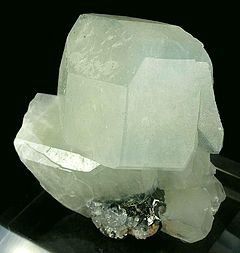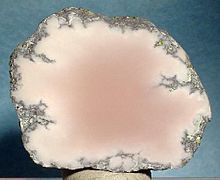- Datolite
-
Datolite 
Datolite on sphalerite from San Luis Potosí, Mexico (size: 6.2 x 5.3 x 2.8 cm)General Category Silicate mineral Chemical formula CaBSiO4(OH) Crystal symmetry Monoclinic prismatic 2/m Unit cell a = 9.62 Å, b = 7.6 Å, c = 4.84 Å; β = 90.15°; Z = 4 Identification Color Colorless or white; may be grayish, yellow, green, red, pink Crystal habit Crystal prismatic, short to tabular; Botryoidal or globular with columnar structure; granular to compact; cryptocrystalline Crystal system Monoclinic Fracture Conchoidal to uneven Tenacity Brittle Mohs scale hardness 5 to 5.5 Luster Vitreous, rarely subresinous on fracture surface Diaphaneity Transparent to translucent, rarely opaque Specific gravity 2.96 – 3.00 Optical properties Biaxial (-) Refractive index nα = 1.626 nβ = 1.653 - 1.654 nγ = 1.670 Birefringence δ = 0.044 2V angle Measured: 74° Dispersion r > v; weak Ultraviolet fluorescence Fluoresces blue under SW UV References [1][2][3] Datolite is a calcium boron hydroxide nesosilicate, CaBSiO4(OH). It was first observed by Jens Esmark in 1806, and named by him from δατεῖσθαι, "to divide," and λίθος, "stone," in allusion to the granular structure of the massive mineral.[4]
Datolite crystallizes in the monoclinic system forming prismatic crystals and nodular masses. The luster is vitreous and may be brown, yellow, light green or colorless. The Mohs hardness is 5.5 and the specific gravity is 2.8 - 3.0.
The type localities are in the diabases of the Connecticut River valley and Arendal, Aust-Agder, Norway. Associated minerals include prehnite, danburite, babingtonite, epidote, native copper, calcite, quartz and zeolites. It is common in the copper deposits of the Lake Superior region of Michigan. It occurs as a secondary mineral in mafic igneous rocks often filling vesicles along with zeolites in basalt. Unlike most localities throughout the world, the occurrence of datolite in the Lake Superior region is usually fine grained in texture and possesses colored banding. Much of the coloration is due to the inclusion of copper or associated minerals in progressive stages of hydrothermal precipitation.
Botryolite is a botryoidal form of datolite.
References
- ^ Handbook of Mineralogy
- ^ Mindat
- ^ Webmineral
- ^
 Chisholm, Hugh, ed (1911). "Datolite". Encyclopædia Britannica (11th ed.). Cambridge University Press.
Chisholm, Hugh, ed (1911). "Datolite". Encyclopædia Britannica (11th ed.). Cambridge University Press.
External links

This article about a specific silicate mineral is a stub. You can help Wikipedia by expanding it.

